Arctic sea ice growth was slower than average through most of the month, but with extent slightly declining towards the end of the month. Antarctic sea ice extent returned to near-record daily lows after a brief excursion out of the lowest five years.
Overview of conditions
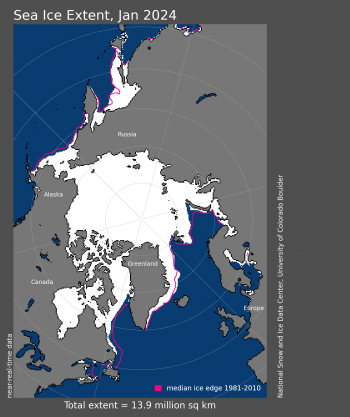
Figure 1a. Arctic sea ice extent for January 2024 was 13.92 million square kilometers (5.37 million square miles). The magenta line shows the 1981 to 2010 average extent for that month. Sea Ice Index data. About the data
Credit: National Snow and Ice Data Center
High-resolution image
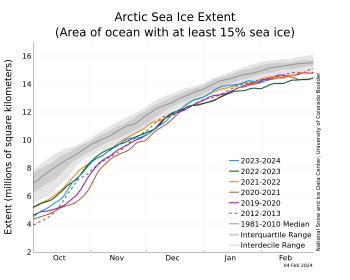
Figure 1b. The graph above shows Arctic sea ice extent as of February 4, 2024, along with daily ice extent data for four previous years and the record low year. 2023 to 2024 is shown in blue, 2022 to 2023 in green, 2021 to 2022 in orange, 2020 to 2021 in brown, 2019 to 2020 in magenta, and 2012 to 2013 in dashed brown. The 1981 to 2010 median is in dark gray. The gray areas around the median line show the interquartile and interdecile ranges of the data. Sea Ice Index data.
Credit: National Snow and Ice Data Center
High-resolution image
The year 2024 began with an average January Arctic sea ice extent of 13.92 million square kilometers (5.37 million square miles), the twentieth lowest in the 45-year satellite record (Figure 1a). During the month, extent increased by 1.09 million square kilometers (421,000 square miles), which was slower than the 1981 to 2010 average increase of 1.33 million square kilometers (514,000 square miles) (Figure 1b). Extent actually declined for a few days at the end of the month. During the growth season, such short-term declines are not unusual at this time of year and are caused by weather systems that temporarily halt ice growth or push the ice northwards.
Extent was low in the Barents Sea with open water extending offshore of the northwest tip of Novaya Zemlya, as well as in the Gulf of St. Lawrence. Elsewhere, extent was near average.
Conditions in context
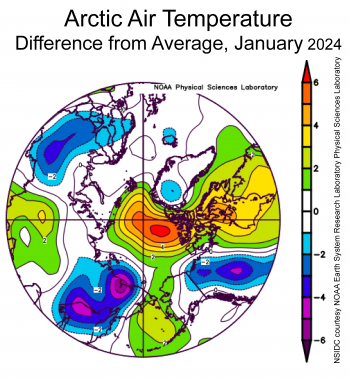
Figure 2a. This plot shows the departure from average air temperature in the Arctic at the 925 hPa level, in degrees Celsius, for January 2024. Yellows and reds indicate above average temperatures; blues and purples indicate below average temperatures.
Credit: NSIDC courtesy NOAA Earth System Research Laboratory Physical Sciences Laboratory
High-resolution image
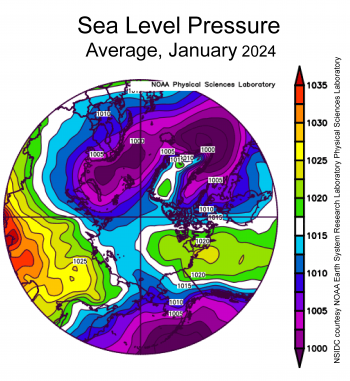
Figure 2b. This plot shows average sea level pressure in the Arctic in millibars for January 2024. Yellows and reds indicate high air pressure; blues and purples indicate low pressure.
Credit: NSIDC courtesy NOAA Earth System Research Laboratory Physical Sciences Laboratory
High-resolution image
Overall, it was relatively warm over the Arctic Ocean during January (Figure 2a). Air temperatures at the 925 millibar level (about 2,500 feet above sea level) were up to 6 degrees Celsius (11 degrees Fahrenheit) above average over the central Arctic Ocean and the Canadian Archipelago. Air temperatures in the Bering Sea were 2 to 3 degrees Celsius (4 to 5 degrees Fahrenheit) above average. It was slightly cooler than average over the East Siberian Sea.
The sea level pressure pattern was characterized by low pressure over the Barents and Bering Seas and a saddle of relatively high pressure extending from Eastern Siberia across the Arctic Ocean into northwestern Canada (Figure 2b). Overall, pressure gradients were not particularly strong, indicating slack winds.
January 2024 compared to previous years
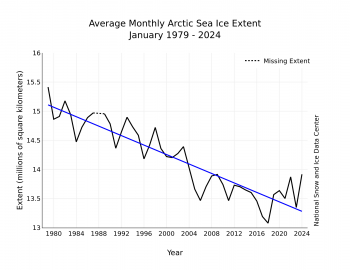
Figure 3. Monthly January ice extent for 1979 to 2024 shows a decline of 2.8 percent per decade.
Credit: National Snow and Ice Data Center
High-resolution image
The downward linear trend in Arctic sea ice extent for January over the 45-year satellite record is 41,000 square kilometers (16,000 square miles) per year, or 2.8 percent per decade relative to the 1981 to 2010 average (Figure 3). Based on the linear trend, January has lost 1.73 million square kilometers (668,000 square miles) of ice since 1979. This is equivalent to the 2.5 times the size of state of Alaska or the country of Iran. However, the relatively high ice extent for January 2024 is notable.
Arctic sea ice thickness update
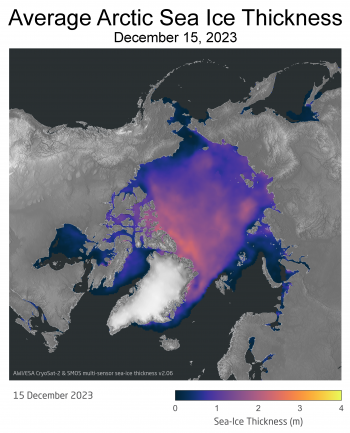
Figure 4a. This map of the Arctic shows average sea ice thickness in meters on December 15, 2023. Warmer colors indicate thicker ice; cooler colors indicate thinner ice. The European Space Agency’s (ESA’s) Soil Moisture Ocean Salinity (SMOS) and CryoSat-2 satellites help determine average sea ice thickness.
Credit: Images from ESA SMOS & CryoSat-2 Sea Ice Data Product Processing and Dissemination Service, provided by Stefan Hendricks, Alfred Wegener Institute
High-resolution image
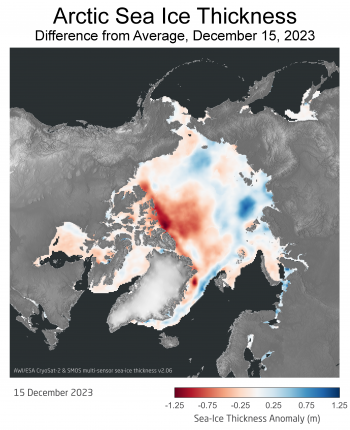
Figure 4b. This map of the Arctic shows sea ice thickness as a difference from the 2011 to 2023 average on December 15, 2023. The European Space Agency’s (ESA’s) Soil Moisture Ocean Salinity (SMOS) and CryoSat-2 satellites help determine average sea ice thickness.
Credit: Images from ESA SMOS & CryoSat-2 Sea Ice Data Product Processing and Dissemination Service, provided by Stefan Hendricks, Alfred Wegener Institute
High-resolution image
Sea ice thickness can be estimated from satellite-borne altimeters. Currently, two altimeters are providing thickness estimates over the Arctic Ocean. One is the NASA Ice, Cloud, Land elevation Satellite 2 (ICESat-2), a laser altimeter; ICESat-2 data products are archived at the NASA Snow and Ice Distributed Active Archive Center (DAAC) at NSIDC. The other is the European Space Agency’s (ESA’s) CryoSat-2, a radar altimeter. In combination with estimates for thin regions from the ESA Soil Moisture Ocean Salinity (SMOS) satellite, CryoSat-2 provides daily updated weekly average thickness (Figure 4a).
As Arctic sea ice extent starts approaching its maximum, ice thickness can provide an indication of the state of the ice cover. The most recent (mid-December 2023) thickness analysis from the ESA SMOS & CryoSat-2 Sea Ice Data Product Processing and Dissemination Service at Alfred Wegener Institute indicates up to 1.25 meters (4.1 feet) thicker ice than the 2011to 2023 average over the Siberian side of the Arctic, with ice on the North American side up to 1.25 meters (4.1 feet) thinner than average (Figure 4b). This suggests that there may be a slower melt out of ice in the Siberian coastal seas, but perhaps faster in the Beaufort Sea.
Antarctic sea ice
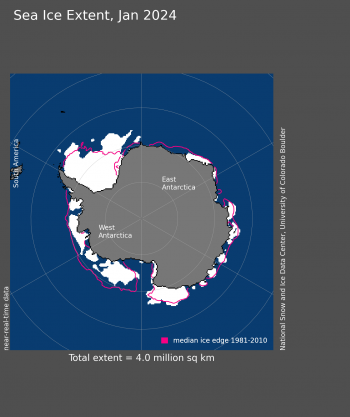
Figure 5. Antarctic sea ice extent for January 2024 was 3.96 million square kilometers (1.53 million square miles). The magenta line shows the 1981 to 2010 average extent for that month. Sea Ice Index data. About the data
Credit: National Snow and Ice Data Center
High-resolution image
Sea ice extent in the Antarctic started the year at 6.37 million square kilometers (2.46 million square miles), or sixth lowest in the satellite record for January 1. As the melt season continued in the Southern Hemisphere, a rapid decline in daily extent led to it ending the month at 2.58 million square kilometers (996,000 square miles), tying for second lowest with 2017 for that date. Antarctic sea ice extent for January overall averaged 3.96 million square kilometers (1.53 million square miles), tying for fourth lowest extent with 2022. Extent was particularly low in the Ross, Bellingshausen, and Amundsen Seas, but has been near average in the Weddell Sea. Little ice remains in the East Antarctic sectors.
A team from the University of Colorado and the Instituto Argentino Antartico are en route to the Antarctic Peninsula and the Larsen B embayment. This region’s glaciers have become more active again after an area of multiyear fast ice broke away in 2022.

